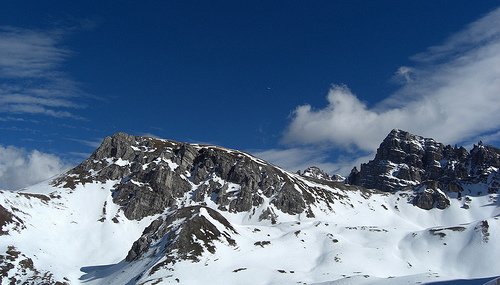Le Alpi rappresentano la più importante fonte di acqua dolce dell’Europa continentale. Data la loro altitudine considerevole, il ciclo idrologico delle Alpi è largamente influenzato dalla neve; la neve è un isolante per il suolo sottostante, determina la distribuzione e lo sviluppo della vegetazione, e abbassa la temperatura superficiale riflettendo la radiazione solare.
Si ritiene che il riscaldamento globale sia responsabile della riduzione della quantità e della durata delle nevicate sulle Alpi; nel corso degli ultimi 30 anni, infatti, nonostante la grande variabilità di anno in anno, si è registrato un accorciamento della stagione delle nevi. A ciò si unisce una variabilità a bassa frequenza (multidecennale) delle precipitazione nevose associata a variazioni su larga scala della circolazione.
In un nuovo studio pubblicato di recente su Environmental Research Letters, un gruppo di ricercatori (fra cui M. Zampieri, E. Scoccimarro, S. Gualdi della Divisione SERC del CMCC) ha messo in luce come la variabilità multidecennale della neve primaverile delle Alpi sia influenzata dall’indice AMO (Atlantic Multi-decadal Oscillation), riferendo variazioni correlate per la fase di AMO e le quantità di neve in primavera.
L’abstract dell’articolo:
Global warming is believed to be responsible for the reduction of snow amount and duration over the Alps. In fact, a rapid shortening of the snowy season has been measured and perceived by ecosystems and society in the past 30 years, despite the large year-to-year variability. This trend is projected to continue during the 21st century in the climate change scenarios with increasing greenhouse gas concentrations. Superimposed on the long-term trend, however, there is a low-frequency variability of snowfall associated with multi-decadal changes in the large-scale circulation. The amplitude of this natural low-frequency variation might be relatively large, determining rapid and substantial changes of snowfall, as recently observed. This is already known for winter snowfall over the Alps in connection with the recent tendency toward the positive phase of the North Atlantic Oscillation. In this study, we show that the low-frequency variability of Alpine spring snowfall in the past 150 years is affected by the Atlantic Multi-decadal Oscillation (AMO), which is a natural periodic fluctuation of Northern Atlantic sea surface temperature. Therefore, the recently observed spring snowfall reduction might be, at least in part, explained by the shift toward a positive AMO phase that happened in the 1990s.
Leggi la versione integrale dell’articolo:
Zampieri M., Scoccimarro E., Gualdi S.
Atlantic influence on spring snowfall over Alps in the last 150 years
2013, Environmental Research Letters, Volume 8, number 3, DOI: 10.1088/1748-9326/8/3/034026




